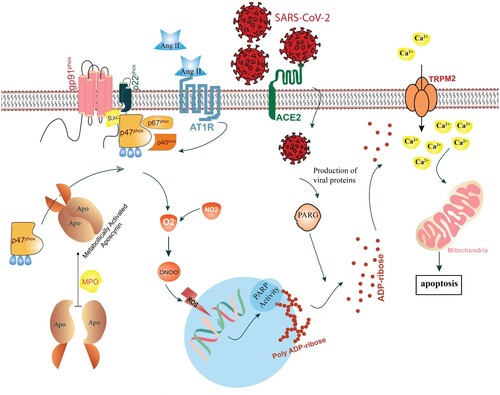Figures & data
Figure 1. Schematic illustration of molecular mechanisms involved in COVID-19 pathogenesis in an infected cell. Upon binding of SARS-CoV-2 to angiotensin-converting enzyme 2 (ACE2), the virus enters the cell. The complex of SARS-CoV-2 and ACE2 triggers the renin-angiotensin system (RAS), leading to up-regulation of angiotensin II (Ag II). Binding of Ag II to angiotensin II type I receptor (AT1R) triggers the NADPH oxidase (NOX) activation and oxidative burst via the downstream signaling pathway. Production of ROS leads to DNA strands break which recruits base excision repair (BER) system to repair DNA damage via Poly(ADP-ribose) polymerase (PARP) activity. PARP subsequently modify through transferring ADP-ribose units to itself. Poly(ADP-ribose) glycohydrolase (PARG) which is encoded by the Coronaviridae family, splits ADP-ribose units from PARP, which leads to ADP ribose accumulation in the cytosol. Direct binding of ADP-ribose unites to transient receptor potential channel melastatin 2 (TRPM2) channels, activates these channels in order to release a large amount of Ca2+ ions to the cell. The Ca2+ overload probably results in a distinct form of cell death named parthanatos. In myeloperoxidase (MPO)-containing cells including polymorphonuclears (PMNs), MPO drives dimerization of apocynin. Active apocynin exerts NOX inhibitory function through a disruption of p47phox subunit translocation to NOX complex.

